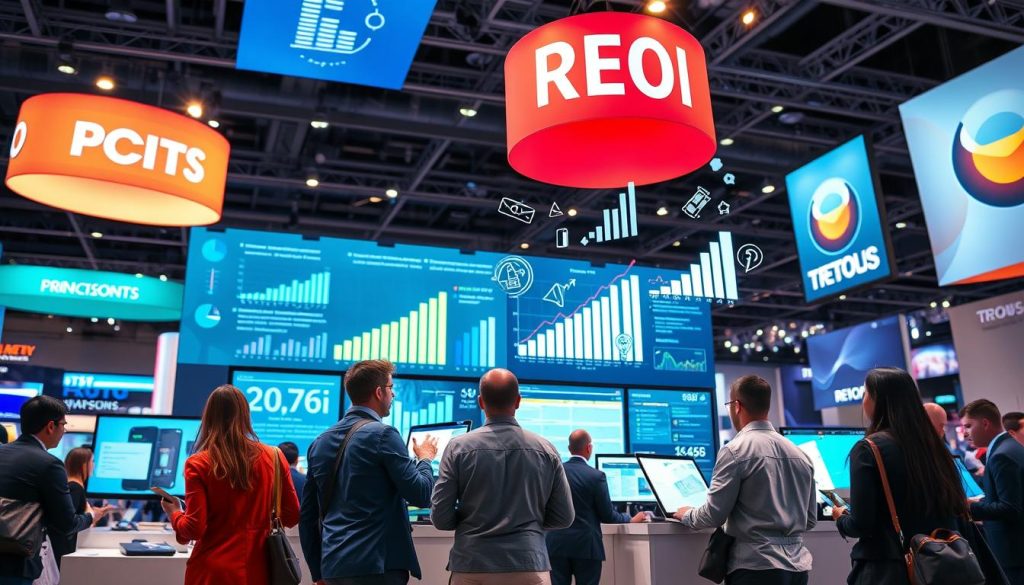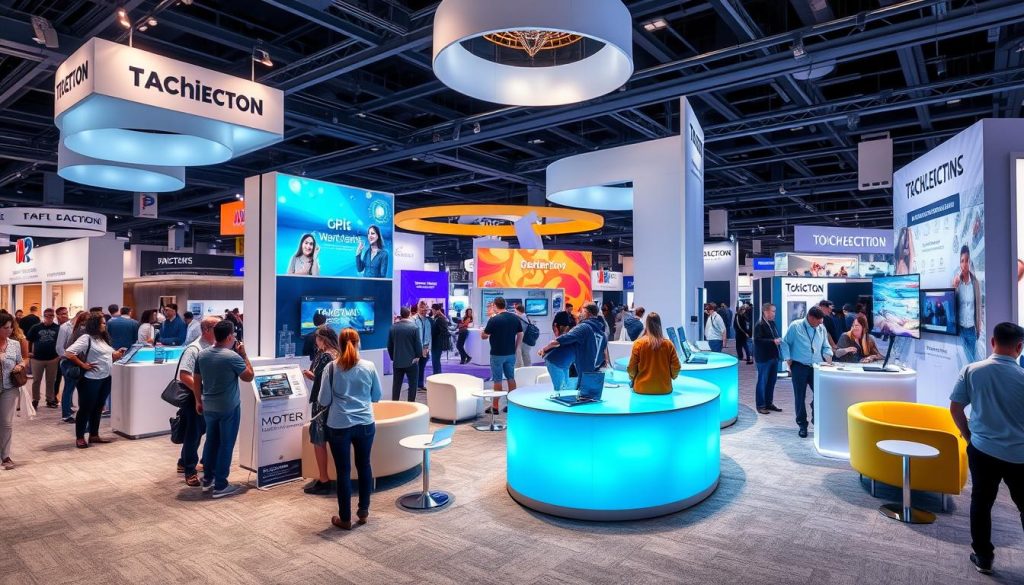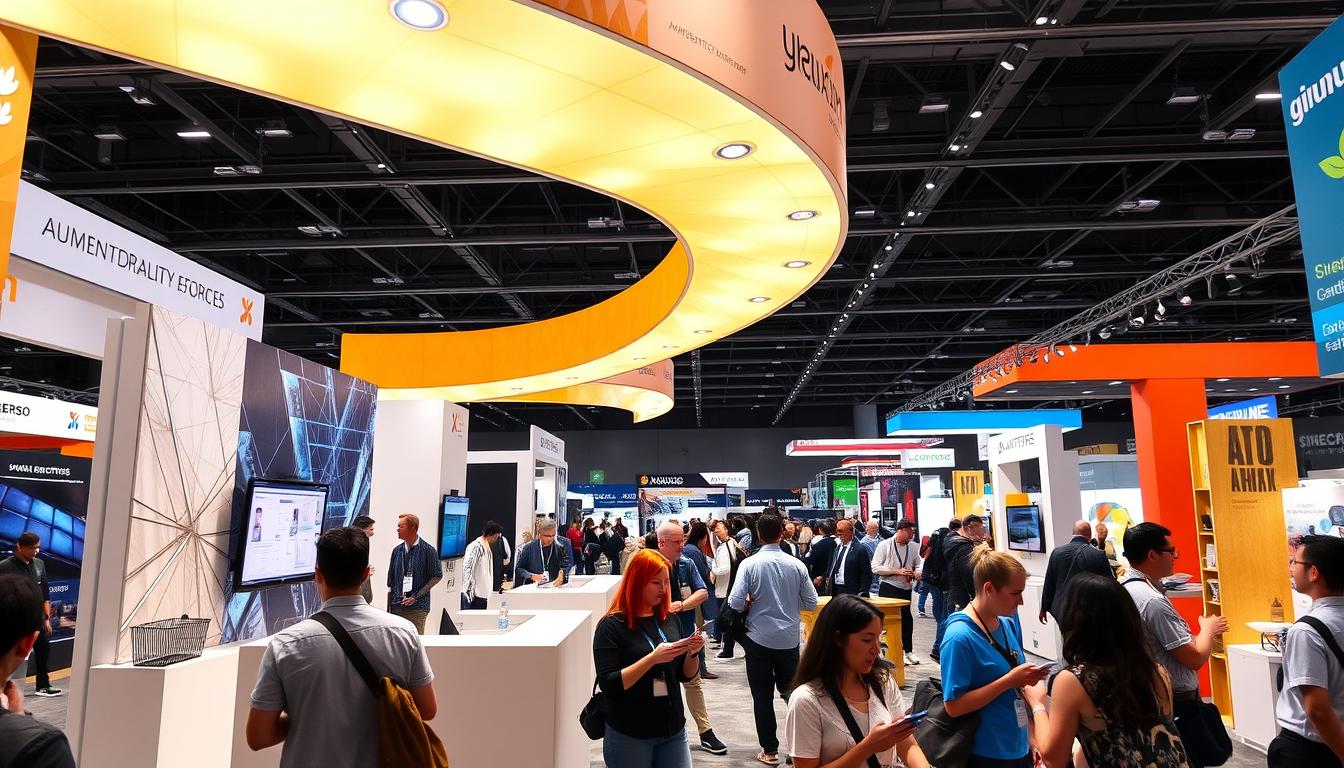Tradeshows have entered a new era, where gamification and interactive branding reign supreme. Today’s exhibitions are far from the static displays of the past. They’re dynamic hubs of engagement, powered by cutting-edge technology and innovative strategies.
In this evolving landscape, trade show engagement has taken on new dimensions. Exhibitors are now crafting immersive experiences that captivate attendees and leave lasting impressions. From touchscreen installations to virtual reality demos, the modern tradeshow floor is a playground of interactive possibilities.
This guide delves into the transformative world of modern tradeshow marketing. We’ll explore how branded games and interactive elements are reshaping the way businesses connect with their audience at these pivotal industry events.
Key Takeaways
- Gamification is revolutionizing tradeshow marketing strategies
- Interactive branding creates memorable experiences for attendees
- Technology integration is key to enhancing trade show engagement
- Immersive experiences are replacing traditional static displays
- Measuring ROI in modern tradeshows requires new metrics and tools
Understanding Modern Tradeshow Marketing Fundamentals
Tradeshow marketing has evolved dramatically in the digital age. Today’s successful exhibitions blend traditional approaches with cutting-edge technology to create immersive experiences that captivate attendees and drive brand awareness.
Evolution of Tradeshow Marketing
Gone are the days of simple booth setups and promotional flyers. Modern tradeshow marketing focuses on experiential marketing techniques that engage visitors on multiple levels. Interactive displays, virtual reality demonstrations, and gamified elements have become staples of successful exhibitions.
Key Components of Successful Modern Exhibitions
Brand activation is at the heart of effective tradeshow strategies. Companies now design their booths as immersive brand experiences, creating memorable interactions that resonate long after the event ends. This approach builds credibility and establishes trust with potential customers.
Integration of Traditional and Digital Marketing Approaches
Successful tradeshow marketing combines the best of both worlds. While face-to-face interactions remain crucial, digital tools enhance these connections. Social media integration, mobile apps, and real-time data analytics help exhibitors maximize their impact and measure ROI effectively.
| Traditional Approach | Modern Integration |
|---|---|
| Printed brochures | Interactive digital catalogs |
| Static displays | Touchscreen presentations |
| Business card exchange | Digital lead capture systems |
| Post-event follow-ups | Real-time engagement and nurturing |
By embracing these modern fundamentals, companies can create powerful tradeshow experiences that drive engagement, generate leads, and deliver measurable results in today’s competitive business landscape.
The Role of Branded Games in Modern Tradeshow Marketing
Branded games have become a game-changer in modern tradeshow marketing. These interactive experiences blend gamification and interactive branding to create unforgettable moments for attendees. By incorporating fun challenges and rewards, companies can boost booth traffic generation and leave a lasting impression on potential clients.
Gamification in tradeshow booths takes many forms. From digital quizzes to physical puzzles, these activities engage visitors and spark conversations. Interactive branding through games allows companies to showcase their products or services in a unique, memorable way. This approach can lead to increased brand recall and stronger connections with leads.
One effective strategy for booth traffic generation is to offer prizes or incentives for game participation. This upselling technique not only draws more visitors but also creates opportunities for meaningful interactions with potential customers.
“Gamification in tradeshow marketing isn’t just about fun—it’s about creating memorable brand experiences that drive results.”
To maximize the impact of branded games, consider these tips:
- Align game themes with your brand message
- Keep rules simple and gameplay quick
- Use technology to track participation and gather data
- Train staff to engage with players and guide them through the experience
By leveraging the power of gamification and interactive branding, companies can transform their tradeshow presence. These engaging experiences not only boost booth traffic generation but also create lasting connections with potential clients, setting the stage for future business opportunities.
Leveraging Interactive Technology for Booth Engagement
Modern tradeshow marketing thrives on interactive technologies that create immersive experiences. These innovations transform booth spaces into hubs of engagement, driving customer acquisition through memorable interactions.
Touchscreen Installations and Digital Displays
Touchscreen displays offer visitors a hands-on experience with products and services. These interactive branding tools allow attendees to explore information at their own pace, enhancing engagement and retention. Digital displays showcase dynamic content, capturing attention and conveying brand messages effectively.
Virtual Reality Integration Solutions
Virtual reality (VR) takes immersive experiences to new heights. By transporting visitors into virtual product demonstrations or brand environments, VR creates lasting impressions. This technology is particularly effective for industries where physical product showcases are challenging, such as real estate or travel.
Mobile App Integration Strategies
Mobile apps extend the booth experience beyond physical boundaries. They facilitate seamless information sharing, appointment scheduling, and personalized follow-ups. Integrating social media features within these apps can amplify reach and engagement, turning booth visitors into brand advocates.
| Technology | Engagement Impact | Customer Acquisition Potential |
|---|---|---|
| Touchscreens | High | Moderate |
| Digital Displays | Moderate | Low |
| Virtual Reality | Very High | High |
| Mobile Apps | High | Very High |
By leveraging these interactive technologies, exhibitors can create compelling booth experiences that resonate with attendees, fostering meaningful connections and driving business growth.
Creating Immersive Brand Experiences
Trade show engagement soars when brands craft unforgettable moments. Experiential marketing transforms ordinary booths into captivating realms that visitors can’t resist. By tapping into the senses, companies forge lasting connections with their audience.
Brand activation takes center stage as businesses push boundaries. Interactive displays, virtual reality simulations, and hands-on product demos breathe life into static exhibits. These dynamic elements spark curiosity and encourage deeper exploration of what a company offers.
Successful exhibitors design multi-sensory journeys. They blend visuals, sounds, textures, and even scents to create a cohesive brand story. This immersive approach leaves a lasting impression, much like effective email marketing campaigns that resonate with customers long after they’ve closed their inbox.
“Immersion is the new currency of brand experiences. It’s not just about seeing your product; it’s about feeling your brand’s essence.”
To maximize trade show engagement, companies should:
- Craft a narrative that guides visitors through the booth
- Incorporate interactive technology that aligns with brand values
- Train staff to facilitate meaningful interactions and conversations
- Create shareable moments that extend beyond the event
By focusing on these elements, brands can turn fleeting encounters into memorable experiences that drive business growth and foster customer loyalty.
Gamification Strategies for Lead Generation
Gamification has revolutionized customer acquisition at tradeshows. By incorporating interactive branding elements, businesses can create engaging experiences that capture leads and boost sales. Let’s explore some effective gamification strategies for lead generation.
Points-Based Reward Systems
Points-based reward systems incentivize attendees to interact with your brand. Visitors earn points for various activities, such as product demonstrations or survey completions. These points can be redeemed for prizes, creating a fun and rewarding experience that encourages participation and data collection.
Competition-Based Engagement Tactics
Competition-based tactics tap into people’s natural desire to win. Leaderboards display top scorers, driving engagement and repeat visits to your booth. Challenges can range from product knowledge quizzes to virtual scavenger hunts, fostering a sense of accomplishment and brand connection.
Social Media Integration Games
Social media integration games extend your reach beyond the tradeshow floor. Encourage attendees to share branded content or participate in hashtag challenges for chances to win prizes. This approach not only generates leads but also increases brand visibility across platforms.
| Gamification Strategy | Benefits | Implementation Tips |
|---|---|---|
| Points-Based Rewards | Increased engagement, data collection | Offer valuable, branded prizes |
| Competition-Based Tactics | Repeat visits, brand connection | Use digital leaderboards for real-time updates |
| Social Media Games | Extended reach, brand visibility | Create shareable, branded content |
By implementing these gamification strategies, you can transform your tradeshow presence into an interactive branding powerhouse. Remember, the key to success lies in creating experiences that are both fun and valuable for attendees. As highlighted in this article on customer service, focusing on enhancing the overall customer experience can lead to increased sales and loyalty.
Measuring ROI in Modern Tradeshow Marketing
In today’s competitive market, measuring return on investment (ROI) is crucial for successful tradeshow marketing. Effective booth traffic generation and customer acquisition strategies require careful analysis to ensure trade show engagement delivers real value.
Key Performance Indicators (KPIs)
To gauge success, focus on these essential KPIs:
- Booth visitors count
- Lead quality score
- Conversion rate
- Social media mentions
- Post-show survey results

Data Collection and Analysis Methods
Gather data through various channels to get a complete picture of your tradeshow performance:
- Digital lead capture systems
- Attendee tracking technologies
- Social media analytics
- Sales team feedback
Analyze this data to identify trends and areas for improvement in your trade show engagement strategies.
ROI Calculation Frameworks
Use these frameworks to calculate your tradeshow ROI:
| Framework | Formula | Best For |
|---|---|---|
| Simple ROI | (Revenue – Cost) / Cost x 100 | Quick assessments |
| Lifetime Value ROI | (Customer Lifetime Value x New Customers) – Cost | Long-term impact |
| Lead-based ROI | (Lead Value x Leads Generated) – Cost | B2B focused events |
By implementing these measurement strategies, you’ll gain valuable insights to refine your booth traffic generation efforts and boost overall customer acquisition at future tradeshows.
Digital Lead Capture and Follow-up Systems
Modern tradeshows offer prime opportunities for customer acquisition. Digital lead capture systems have revolutionized how businesses collect and manage attendee information. These tools streamline the process, making it easier to gather valuable data for future marketing efforts.
Interactive branding plays a crucial role in attracting potential leads. By using tablets or mobile devices, exhibitors can quickly collect contact details, preferences, and interests. This data integrates seamlessly with Customer Relationship Management (CRM) systems, enabling personalized follow-ups.
Experiential marketing at tradeshows goes hand-in-hand with digital lead capture. Engaging activities, such as product demonstrations or virtual reality experiences, can be linked to data collection points. This approach ensures a memorable brand interaction while gathering essential information.
“Digital lead capture systems have transformed our tradeshow strategy. We’ve seen a 40% increase in qualified leads since implementing these tools.”
Post-event follow-up is critical for converting leads into customers. Automated email campaigns, personalized based on collected data, keep your brand top-of-mind. Social media retargeting can also reinforce your message to those who showed interest at the event.
To maximize the effectiveness of your digital lead capture system, consider these key features:
- Real-time data syncing
- Customizable lead forms
- Badge scanning capabilities
- Integration with marketing automation tools
- Analytics and reporting functions
By leveraging these digital tools, businesses can enhance their customer acquisition strategies and create more impactful follow-up campaigns. The result is a more efficient and effective tradeshow marketing experience.
| Lead Capture Method | Pros | Cons |
|---|---|---|
| Digital Forms | Fast, accurate, easy to integrate | Requires internet connection |
| Badge Scanning | Quick, minimal data entry | Limited additional information |
| Interactive Kiosks | Engaging, collects detailed data | Higher cost, space requirements |
Designing an Effective Interactive Booth Layout
Creating a captivating booth layout is crucial for trade show engagement and booth traffic generation. A well-designed space can transform your exhibit into a hub of immersive experiences, drawing visitors and leaving a lasting impression.
Traffic Flow Optimization
Optimizing traffic flow is key to maximizing interactions. Design your booth with clear pathways that guide visitors through your displays. Use strategically placed signage and lighting to direct attention to key areas. Consider an open layout that allows for easy movement and encourages exploration.

Technology Integration Points
Incorporate technology seamlessly into your booth design to enhance visitor experiences. Place interactive touchscreens at eye level for easy access. Consider virtual reality stations that showcase your products or services in immersive environments. Use digital displays to highlight key information and attract passersby.
Engagement Zone Planning
Create dedicated areas within your booth for different types of interactions. Plan spaces for one-on-one conversations, group demonstrations, and hands-on product experiences. Include a central attraction that serves as a focal point and draws visitors into your booth.
| Zone Type | Purpose | Elements |
|---|---|---|
| Welcome Area | Initial engagement | Digital welcome screen, greeters |
| Demo Space | Product showcasing | Interactive displays, VR stations |
| Consultation Corner | In-depth discussions | Comfortable seating, private booths |
| Social Hub | Networking | Charging stations, refreshment area |
By thoughtfully designing your booth layout, you can create a space that not only attracts visitors but also facilitates meaningful interactions, ultimately boosting your trade show success.
Social Media Integration and Live Event Marketing
Social media has revolutionized brand activation at tradeshows. By integrating platforms like Instagram and Twitter, companies create buzz and extend their reach beyond the booth. Live event marketing amplifies this effect, turning attendees into brand advocates.
Interactive branding thrives on real-time engagement. Encourage visitors to share their experiences using custom hashtags or photo contests. This not only boosts visibility but also generates valuable user-generated content for future marketing efforts.
Experiential marketing shines through live demonstrations and product launches streamed on social platforms. These events create shareable moments, drawing virtual audiences into the tradeshow experience.
“Social media integration transforms tradeshows from local events to global brand experiences.”
To maximize impact, consider these strategies:
- Set up a social media command center at your booth
- Use QR codes to link physical displays with digital content
- Create Instagram-worthy photo ops for organic sharing
- Host live Q&A sessions with industry experts
Effective social media integration can significantly boost ROI. Understanding trends in digital engagement is crucial for success in modern tradeshow marketing.
| Platform | Best Use | Engagement Tactic |
|---|---|---|
| Visual Storytelling | Stories, Reels, Live | |
| Real-time Updates | Live Tweeting, Polls | |
| B2B Networking | Thought Leadership Posts | |
| TikTok | Viral Challenges | Hashtag Campaigns |
Post-Show Engagement and Lead Nurturing
After the buzz of a trade show fades, the real work begins. Effective post-show engagement is key to turning leads into loyal customers. Let’s explore strategies to keep the momentum going and maximize your customer acquisition efforts.
Follow-up Campaign Strategies
Quick and personalized follow-ups are crucial. Craft emails that remind attendees of their booth experience, highlighting the unique aspects of your trade show engagement. Email marketing agencies can help design campaigns that nurture leads and drive conversions.
Content Marketing Integration
Extend the life of your trade show content by repurposing it for various channels. Create blog posts, videos, or infographics that showcase your products or services. This keeps your brand top-of-mind and provides value to potential customers.
Lead Scoring and Qualification
Not all leads are created equal. Use a scoring system to prioritize follow-ups:
| Lead Type | Score | Follow-up Action |
|---|---|---|
| Hot Lead | 80-100 | Immediate personal call |
| Warm Lead | 50-79 | Personalized email within 48 hours |
| Cool Lead | 20-49 | Add to nurture campaign |
| Cold Lead | 0-19 | General newsletter subscription |
Implement gamification elements in your follow-up strategy to boost engagement. Offer points for interactions or create challenges that encourage leads to learn more about your offerings. This approach can significantly enhance your customer acquisition process and keep the trade show excitement alive long after the event ends.
Training Staff for Interactive Engagement
In modern tradeshow marketing, staff training is key to success. Your booth team needs to be ready for interactive branding and experiential marketing. They must know how to use tech tools and guide visitors through immersive experiences.
Teach your staff about your brand’s story and values. This helps them create real connections with booth visitors. Make sure they can explain your products or services in a clear, friendly way. Role-playing exercises can help them practice these skills.
Tech skills are vital in today’s tradeshows. Your team should be comfortable with all the digital tools in your booth. This includes touchscreens, VR headsets, or custom apps. Regular practice sessions will boost their confidence in using these tools to engage visitors.
Remember, your staff is the human touch in your high-tech booth. They bring warmth to your interactive displays and immersive experiences. By investing in their training, you’re setting the stage for meaningful connections and lasting impressions at your next tradeshow.






